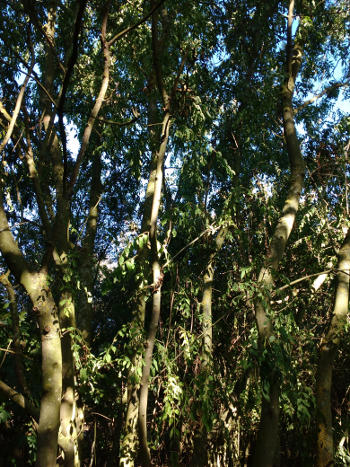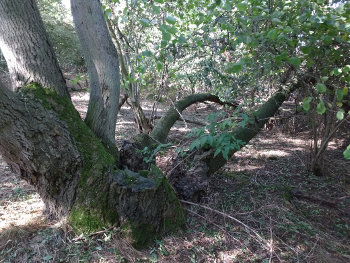
Chalara ash dieback – first appearance in mature ash?
It’s several years since what we are now calling Chalara ash dieback was first talked about as a threat to the UK’s stock of ash, Fraxinus excelsior. I think I first saw it in the flesh two or three years ago and at Bottoms’ Corner, our wood in Gravenhurst, in autumn 2014. It was certainly pretty widespread in the wood last year, particularly on young, self-sown trees. Very young plants appear mostly to have died whereas older ones retain some living leaves. I suspect they will succumb next year.
At Bradfield Woods in January this year we saw the first mature coppice stools of ash affected. Plants that had been coppiced during the winter of 2014/15 had sprouted as usual in spring 2015 but it would seem the whole massive plant had died back that summer.That’s a lot of tree to kill and I guess there’s a chance that a plant can recover, but it looked pretty bad. I saw the same thing at Treswell Wood, a lovely bit of woodland managed by the Nottinghamshire Wildlife Trust, last weekend during the National Coppice Federation’s annual AGM gathering.
This week, taking some time to look closely at our wood in preparation for preparing a Woodland Management Plan, we saw the first signs of what we took to be Chalara symptoms in a couple of our old coppice stools. They certainly look sick and although I’m no expert I fear the worse. These are real veterans. Curiously, we’ve only seen symptoms in trees that were coppiced nineteen years ago – relatively recent compared to some of the others that haven’t been cut for perhaps over eighty years. I guess the bigger the stem, the longer an infection takes to have a visible effect. We were told on Saturday that each dying ash leaf can produce millions of spores. These are wind-borne and will, apparently, be everywhere – inside you house, covering your cat… ..so no ash tree can hope to escape merely by its location in the same way as some elms appear to have avoided infection by Dutch elm disease. Loosing trees that are many hundreds of years old would be upsetting to say the least. They are as significant as any other ancient thing we humans cherish.

An ancient ash stool collapsed under its own weight
Collapsing coppice
So if it’s young growth that is succumbing first, let’s not coppice because that would kill the trees. This seems to be the current consensus floating around. Well maybe, but in many cases inaction could kill them anyway. Coppiced ash that’s many decades away from its last cut, has a habit of collapsing. Its wood is famously good at splitting along the grain – a characteristic that wins it plenty of support in woodworking circles but one that works against it when stems grow to a great size and splay out as a result of competition for light. The weight combined often with rot as well as insect and woodpecker attack can lead to a loss of stems one at a time. Unlike other species that are able to carry on growing when more or less horizontal, our ash seems to die when this happens.
What to do?
It’s difficult to know. The process of writing a woodland management plan should bring with it some top advice from the Forestry Commission. My feeling is to take a deep breath and coppice as usual. If most will die anyway, why prolong the agony? At least then we will harvest a quantity of wood whilst it’s still in good nick. The hope generally seems to be that a significant number of ash will have a natural immunity to Chalara and from these, a future resistant population will be propagated. There’s similar work happening currently with English elm and because ash is a far more diverse species genetically, I remain optimistic that it has a future, albeit one that I won’t see.
